Categories: How does it work
Number of views: 42795
Comments on the article: 3
How are uninterruptible power supplies (UPS) arranged and working?
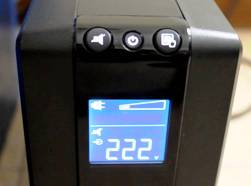 The requirements for the quality of electricity are legally prescribed by state standards and fairly stringent standards. Electricity supply organizations make a lot of efforts to comply with them, but they are not always implemented.
The requirements for the quality of electricity are legally prescribed by state standards and fairly stringent standards. Electricity supply organizations make a lot of efforts to comply with them, but they are not always implemented.
In our apartments, and in production, periodically arise:
-
complete blackouts for an indefinite time;
-
aperiodic short-term (10 ÷ 100 ms) high-voltage (up to 6 kV) voltage pulses;
-
surges and voltage drops with various durations;
-
overlays of high-frequency noise;
-
frequency departures.
All these malfunctions adversely affect the work of household and office consumers of electricity. Microprocessor and computer devices, which not only fail, but can completely lose their performance, are especially affected by the quality of power supply.
Purpose and types of uninterruptible power supplies
To reduce the risks from malfunctions of the power supply network, redundant devices are used, which are commonly called uninterruptible power supplies (UPS) or UPS (formed from the abbreviation of the English phrase "Uninterruptible Power Supply").
They are made with different designs to solve specific consumer problems. For example, powerful UPSs with helium batteries can support the power supply of an entire cottage for several hours.

Their batteries receive a charge from a power line, a wind generator, solar panels or other energy carriers through the rectifier device of the inverter. They feed the electrical consumers of the cottage.
When the external source is turned off, the batteries are discharged to the load connected to their network. The larger the battery capacity and the lower their discharge current, the longer they work.
Medium power uninterruptible power supplies can reserve power supply for electric boilers, indoor climate control systems and similar equipment.
At the same time, the simplest UPS models can only complete a computer emergency shutdown program. Moreover, the duration of the entire process of their work will not exceed 9-15 minutes.
Computer uninterruptible power supplies are:
-
built into the device case;
-
external.
The first designs are common in laptops, netbooks, tablets and similar mobile devices powered by a built-in battery, which is equipped with a power and load switching circuit.
Laptop battery with integrated controller is an uninterruptible power supply. Its circuit in automatic mode protects the operating equipment from power outages.
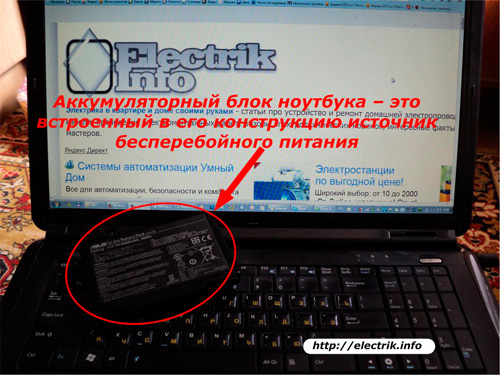
External UPS designsdesigned for the normal completion of programs on a stationary computer are made in a separate unit.
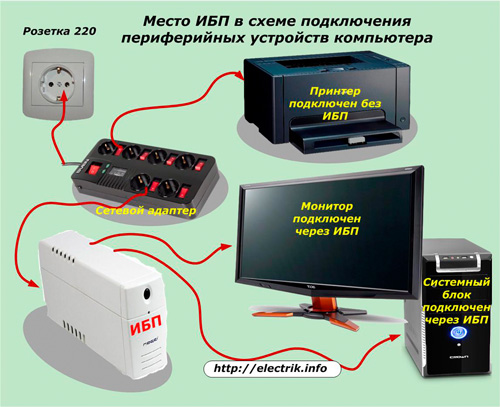
They are connected via a power adapter to an electrical outlet. Only devices that are responsible for the operation of the programs are powered from them:
-
system unit with a connected keyboard;
-
monitor showing ongoing processes.
Other peripherals: scanners, printers, speakers and other equipment from UPS do not power. Otherwise, upon emergency termination of the programs, they will take over part of the energy stored in the batteries.
UPS Workflow Design Options
Computer and industrial UPS are manufactured according to three main options:
-
power backups;
-
interactive circuitry;
-
double conversion of electricity.
With the first method backup circuit, denoted by the English terms “Standby” or “Off-Line”, the voltage is supplied from the network to the computer via the UPS, in which electromagnetic interference is eliminated by the built-in filters. Set here battery, the capacity of which is supported by the charge current regulated by the controller.
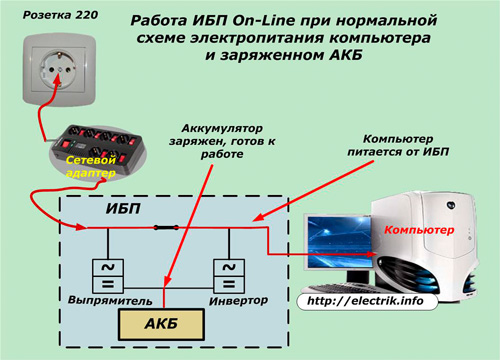
When the external power supply disappears or goes beyond the established standards, the controller directs the battery energy to power consumers. A simple inverter is connected to convert DC to AC.
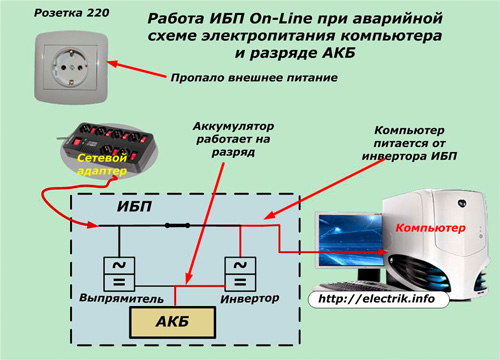
Benefits of UPS Standby
Uninterruptible power supplies of the Off-Line circuit have high efficiency, when the voltage is applied to them, they work quietly, produce little heat and are relatively cheap.
disadvantages
UPS Standby stand out:
-
a long transition to battery power 4 ÷ 13 ms;
-
a distorted shape of the output signal issued by the inverter in the form of a meander, and not a harmonious sine wave;
-
lack of adjustment of voltage and frequency.
Such devices are most common on personal computers.
UPS interactive circuit
They are designated by the English term “Line-Interactive”. They are carried out according to the previous, but more complicated scheme due to the inclusion of a voltage stabilizer using an autotransformer with step regulation.
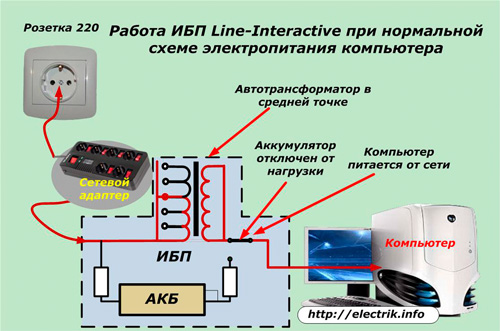
This provides an adjustment of the output voltage, but they are not able to control the frequency of the signal.
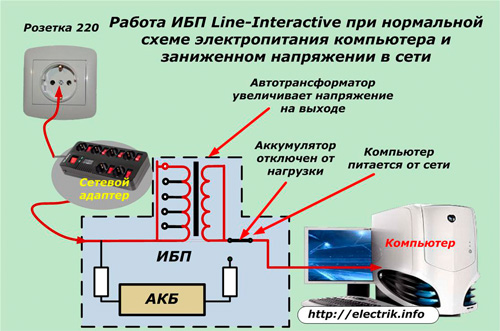
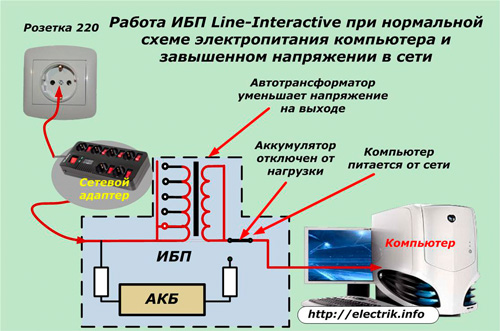
Filtering interference in normal mode and switching to inverter power in the event of an accident occurs according to UPS Standby algorithms.
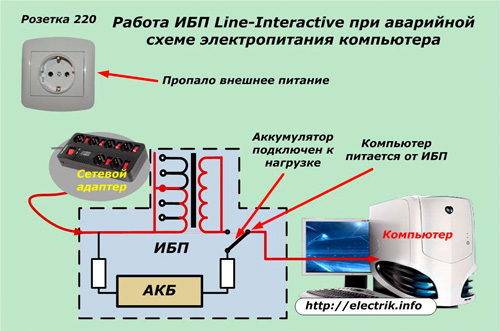
By adding a voltage stabilizer of various models with control methods, they allowed to create inverters with a waveform of not only the meander, but also the sinusoids. However, a small number of control stages based on relay switching does not allow to realize the full stabilization functions.
This is especially true for cheap models, which, when switching to battery power, not only overestimate the frequency above the nominal, but also distort the shape of the sine wave. The interference is made by the built-in transformer, in the core of which hysteresis processes occur.
In expensive models, inverters operate on semiconductor switches. UPS Line-Interactive have a higher performance when switching to battery power than the Off-Line UPS. It is provided by the operation of synchronization algorithms between the incoming voltage with the issued signals. But at the same time there is some underestimation of the efficiency.
Line-Interactive UPS cannot be used to power induction motors, which are massively installed on all household appliances, including heating systems. They are used to operate devices with impulse blockswhere power is filtered and rectified simultaneously: computers and consumer electronics.
Double conversion UPS
This UPS circuit has been named after the English phrase “On-line” and operates on equipment requiring high-quality power. It produces a double conversion of electricity, when the sinusoidal harmonics of the alternating current are constantly converted by the rectifier into a constant value, passed through the inverter to create a repeated sinusoid at the output.
Here, the battery is constantly connected to the circuit, which eliminates the need for its switching. This method virtually eliminates the period of preparation of the uninterruptible power supply for switching.
The operation of the On-line UPS by the state of the battery can be divided into three stages:
-
charge stage;
-
waiting state;
-
discharge to the computer.
Charge period
The sine wave input and output circuits are broken by the UPS internal switch.
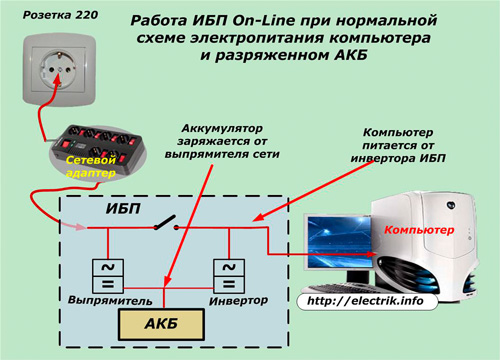
A battery connected to the rectifier receives charge energy until its capacity is restored to optimal values.
Readiness period
After the end of the battery charge, the uninterruptible power supply automation closes the internal switch.

The battery maintains a standby state in the buffer mode.
Discharge period

The battery is automatically transferred to the power of the computer station.
Uninterruptible power supplies operating by the method of double electric power conversion have lower efficiency in the line supply mode than other models due to the energy consumption for heat and noise. But in complex designs, techniques are used to increase efficiency.
UPS On-line can correct not only the magnitude of the voltage, but also its frequency of oscillation. This compares them favorably with previous models and allows them to be used to power various complex devices with asynchronous motors. However, the cost of such devices is much higher than previous models.
UPS Composition
Depending on the type of working circuit, the uninterruptible power supply kit includes:
-
batteries for energy storage;
-
Charger, ensuring the maintenance of battery performance;
-
inverter for forming a sine wave,
-
process control scheme;
-
software.
For remote access to the device, a local network can be used, and you can increase the reliability of the circuit due to its redundancy.
In some uninterruptible power supplies, the Bypass mode is used, when the load is supplied by the filtered mains voltage without operation of the main circuit of the device.
Part of the UPS has a step-by-step voltage regulator "Booster", controlled by automation.
Depending on the need to perform complex technical solutions, uninterruptible power supplies can be equipped with additional special functions.
Read also on this topic:How to choose a UPS for the boiler
See also at i.electricianexp.com
:
